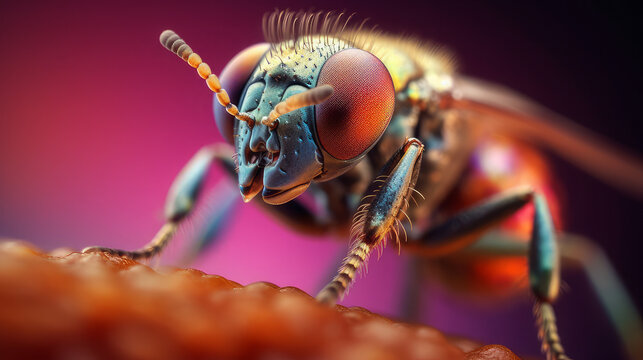Last Updated on January 22, 2024 by Sharon Advik
Ready to dive into the intricate world of insect photography?
You’re in the right place!
Picking the right lens can make or break your quest for that perfect shot of a dragonfly in mid-flight or an ant carrying food back to its colony.
Trust me, I’ve been down that path and know the struggle.
You might wonder, ” Which is the perfect lens for insect photography?”
We’re talking about the macro lenses that give you sharp focus, impeccable magnification, and vivid color reproduction.
So, are you ready to take your insect photography to the next level?
But first, let’s look at the factors you need to look for in a macro lens.
What to Look for in a Macro Lens?
Magnification Ratio
Regarding macro lenses, the magnification ratio is the bread and butter.
You want a 1:1 ratio for life-size images.
Remember when you tried to capture the intricate veins on a dragonfly’s wings?
A 1:1 magnification ratio lets you do just that.
Lower ratios like 1:2 are okay for bigger subjects, but for those jaw-dropping, ultra-detailed shots, you need to aim for 1:1.
The closer you get to your tiny subjects, the more astounding your photos will be.
Focal Length
The focal length between 90mm and 105mm range gives you enough distance from the insects so you won’t scare them off.
Trust me, nothing’s worse than lining up a perfect shot to have your subject fly away!
Plus, these focal lengths offer superb detail.
You’ll see every hair on that bee’s back!
Ready to zoom into an insect’s world like never before?
Additional Features
Don’t overlook the extra bells and whistles a lens can offer.
Image stabilization is a godsend when you’re crouched in awkward positions to get the perfect shot.
Trust me, shaky hands can ruin a masterpiece.
Also, look for quick and quiet autofocus.
Insects won’t wait for your lens to catch up, right?
Weather sealing is another perk, especially if you’re trekking through dewy grass or light rain.
Some lenses even come with special coatings to minimize lens flare and ghosting because the last thing you want is a washed-out photo when the light hits just wrong.
Which are the Best lens for insect photography?
Here are my recommended top 5 Best lens for insect photography:-
FUJIFILM XF 80mm f/2.8 R LM OIS WR Macro: (Best Fuji lens for insect photography)
It felt like a tomorrow when I was deep in the Amazon Rainforest, the buzz of insects filling the air.
You could hear crickets singing their symphony, but the show star was this elusive butterfly, its wings shimmering in hues of gold and blue.
Every photographer in the field had tried to capture its beauty, and all had failed.
Until, of course, I brought out my secret weapon: FUJIFILM XF 80mm f/2.8 R LM OIS WR Macro Lens
Macro Magnification/Razor-Sharp Optics
The one thing that set me apart? The lens.
With 1:1 magnification and razor-sharp optics, I could get up close and personal.
It was as if the lens whispered to the butterfly, “Trust me.”
And oh boy, did it deliver.
The texture of the wings, the droplets of dew on the antennae – every tiny detail was brought to life.
Optical Stabilization
Jungles aren’t known for their stillness, mind you.
Between the swaying branches and my heartbeat accelerating from the excitement, a blurry shot was almost a given.
But, the optical image stabilization steadied the frame like an old friend holding your hand. Result?
Crystal-clear shots even with the sway of the jungle winds.
Teleconverter Compatibility
I had to keep up as the butterfly danced away into the deeper forest.
This lens has teleconverter compatibility, a blessing in disguise.
So even when the butterfly decided to play hard to get, I could extend my focal length and still keep the image quality pristine.
No compromises. Isn’t that what we all want?
Why This Lens is Best for Insect Photography?
Think about it.
A lens that gives you the finest details up close keeps your frame steady when your hands might not be and allows you the flexibility to adapt.
Its all-weather design ensures you’re good to go, rain or shine.
And did I mention the fluorine coating?
Say goodbye to smudges and hello to crisp, flawless shots.
Conclusion
To wrap it all up, the magic lies in the lens.
The story of capturing the elusive Amazonian butterfly wasn’t just my skill – it was having the right tool.
A tool that meets you halfway and then some.
Remember that this lens could be the difference between a missed chance and a masterpiece when you’re in the heart of nature.
So, are you ready to create your own story with this best lens for insect photography?
Olympus M.Zuiko Digital ED 60mm f/2.8 Macro: (Best Olympus lens for insect photography)
I’m out in the field, surrounded by nature’s symphony – the rustling leaves, the distant chirping, and the soft hum of wings.
My lens is my compass, and my camera is a canvas for capturing the miniature wonders most ignore.
Let me take you back to a moment that truly defined why I rely on my Olympus M.Zuiko Digital ED 60mm f/2.8 Macro lens and, more importantly, why I trust it with every shot.
1:1 Magnification
So, there I was, eye to eye with a delicate dragonfly, its iridescent wings catching the sunlight.
With the Olympus M.Zuiko lens attached, it was as if I could see the universe within those intricate patterns.
A 1:1 magnification ratio meant no detail was too small and no curve too subtle to escape my lens.
I was in awe of the unseen world before me, and this lens made it possible.
Minimal Distortion
Do you know the frustration of capturing something extraordinary only to find that the final image doesn’t do justice?
Well, not with my lens.
Its minimal distortion meant that what I saw through the viewfinder was what I got in the photograph.
They are no more battling with warped proportions, just pure, unadulterated beauty.
Tack-Sharp at f/4/Focus Limiter Switch
A dew-covered leaf in the background and the dragonfly itching its way up.
I wanted to capture that detail, every water droplet on its body.
The lens performed like a dream, maintaining sharpness even at f/4.
When I needed to switch focus between close-ups and slightly farther subjects, the focus limiter switch became my best friend.
No more hunting for focus, just smooth, precise adjustments.
Why This Lens Is Best for Insect Photography?
You might wonder why this lens is my go-to choice for insect photography.
It’s simple. This lens doesn’t just capture insects; it immortalizes their essence.
With features like a weather-resistant design, I can chase after those magical moments without worrying about the elements.
Rain or shine, my lens and I are in sync, ready to seize the perfect shot.
Conclusion
In the grand tapestry of nature, every insect has a story to tell, a tale of resilience and beauty.
With the Olympus M.Zuiko Digital ED 60mm f/2.8 Macro lens, I’ve been able to weave those stories into timeless photographs.
It’s not just a lens; it’s a portal to a world that often escapes the human eye.
So, the next time you see a dragonfly dance or a caterpillar explore, remember, with this best lens for insect photography, you can share in their secret lives, too.
Canon MP-E 65mm f/2.8 1-5x Macro: (Best Canon lens for insect photography)
A scorching afternoon in the Arizona desert, the sun blazing down, creating illusions in the air.
I’m there, lying on my belly, face inches from the sand, tracking the elusive “Velvet Ant,” which is a flightless wasp, believe it or not.
Now, you might think I’m mad, but let me tell you, the shots I got were worth every gritty mouthful of sand. Why?
Because my Canon MP-E 65mm f/2.8 1-5x Macro lens didn’t just capture an image; it captured the essence of this fascinating creature.
Manual Focus Macro Photography from 1~5x
This is where my lens shines. In this stark environment, autofocus is a gamble. But manual focus?
Oh, it gives you the control you need.
At 5x magnification, I was not just looking at a Velvet Ant; I was entering its world.
I could see the intricate patterns on its body, the fine hairs, and the miniature eyes looking back at me.
It was like having a microscope attached to my camera.
Fast and Bright
Time is of the essence in the desert.
The velvet ant moves fast, and the light conditions can be harsh.
At f/2.8, this lens is bright enough to give me the shutter speed to freeze motion without losing detail.
There is no blur, just crisp, vivid images that jump at you.
It’s like having a sun illuminating the exact spot you need it to.
Focal Length: 65mm
65mm might sound like a weird focal length for insect photography, but here’s the deal – it gives you enough distance not to scare your subject away while still being close enough to capture the finest details.
This was crucial for the velvet ant, known for its painful sting.
I got my shot and kept my dignity – no strings attached!
Why This Lens is Best for Insect Photography?
This lens is the Holy Grail for insect photography.
The range from 1:1 to 5:1 magnification means you can go from capturing the velvet ant’s environment to its microscopic hairs in a split second.
Add a bright aperture and a detachable, rotatable tripod collar that locks securely.
You’re in for an experience, not just a photo session.
Conclusion
That scorching afternoon, they brought me face-to-face with a creature most people avoid.
But it wasn’t just about the velvet ant; it was about seeing the unseeable and capturing the essence of life in its tiniest forms.
This lens isn’t just a piece of equipment; it’s a window to another world.
Ready to open it with this best lens for insect photography?
Sigma 105mm f/2.8 EX DG OS HSM Macro: (Best 3rd party lens for insect photography)
It’s dawn, and I’m crawling through a dew-soaked park in the heart of my New York city.
I was hunting for the ever-elusive Golden Tortoise Beetle, a tiny critter that can change its colors like a mood ring.
And there it was, clinging to a leaf, changing hues from metallic gold to vivid red and back again.
At this moment, I knew my lens of choice would make or break this shoot, capturing the essence of this tiny, magical being.
And the Sigma 105mm f/2.8 EX DG OS HSM Macro lens didn’t disappoint.
Smooth Focus Ring
All I needed that day was manual focus, and not just any focus – a focus ring that is smooth as silk, allowing you to micro-adjust in split seconds.
As the beetle scurried along the leaf that morning, my lens didn’t falter.
A small twist of the wrist and bam!
The beetle’s eye was focused, and its iridescent colors were captured in all their glory.
It was as if the lens and I were in sync, understanding the importance of this fleeting moment.
Controlled Chromatic Aberration
Color fringing is the enemy of clarity, especially when trying to capture an insect that’s a master of color itself.
I can’t stress enough how this lens controls chromatic aberration.
The two SLD elements in the lens work in harmony to ensure that the colors remain true to life.
That morning, every hue shift of the golden tortoise beetle – from gold to orange to red – was captured with such fidelity that it felt like the beetle could leap out of the image at any moment.
Versatile Aperture
The versatility of the aperture settings on this lens is nothing short of a photographer’s dream.
With an f/2.8 to f/22 range, you can go from dreamy bokeh to pin-sharp focus instantly.
When framing the golden tortoise beetle, I chose an aperture of f/5.6.
It gave me that middle ground: enough depth of field to capture every shimmering detail on the beetle, yet soft enough to blur out the surrounding foliage.
Why This Lens is Best for Insect Photography?
Beyond its superb build quality, this lens has features like a Hyper Sonic Motor AF System and OS Image Stabilization.
And let’s not forget its solid, well-built design that can withstand the elements.
If your lens can’t endure a morning’s dew or a sudden rain shower, what’s the point?
Conclusion
As I finished capturing those incredible shots of the special tortoise beetle, I couldn’t help but think how every feature of my lens came into play, working in unison to create something truly extraordinary.
Isn’t it time you experienced that level of craftsmanship and precision with this best lens for insect photography?
Sony FE 90mm f/2.8 Macro G OSS: (Best Sony lens for insect photography)
So there I was, hanging out in a suburban neighborhood at dawn, eye to eye with a mantis.
Ever seen one up close?
They are like tiny, green ninjas of the insect world, with triangular heads that can swivel 180 degrees.
I’d been chasing this fellow for 20 minutes, both of us sizing each other up.
The challenge was capturing this praying mantis’s beauty and intricacy; my lens was my greatest ally.
Welcome the Sony FE 90mm f/2.8 Macro G OSS lens!
Minimal Distortion/Maximum Optical Stabilization
How many lenses distort images at the edges and ruin photographers’ hard work?
Fortunately, this lens doesn’t do that.
It was surreal to me how it portrayed the mantis, its forearms poised like a kung fu master.
The Optical SteadyShot was a game-changer, giving me a fighting chance to get a sharp shot while this little guy did his acrobatics.
Magnification/ Even Illumination
In macro photography, 1:1 magnification is where the magic happens.
I saw the mantis’s spiky forearms in crazy detail, like each tiny spike was a miniature skyscraper.
And let’s talk about even illumination.
The early morning light was iffy, but thanks to this lens, the light distribution across the frame was so even that every detail popped.
Focus Limiter Switch/Real Manual Focus Feel
Catching a mantis with your lens is no easier than handling a Monday blues.
These critters are quick.
The focus limiter switch helped me zone in faster.
But here’s the deal: sliding that focus ring for manual adjustments was like turning the volume knob on an old radio – smooth, precise, and oh-so-satisfying.
Why This Lens is Your Best Bet for Insect Photography?
I must say, this lens is a go-to for insect pros.
It covers everything from its Direct Drive Super Sonic Wave AF Motor to the Focus Hold Button and Focus Range Limiter.
We’re talking top-tier features that transform your insect shoots from excellent to jaw-dropping.
If you want to capture those shots, I highly recommend this best lens for insect photography.
Conclusion
I have to say, that morning with the mantis was more than just another gig.
It was like a perfectly choreographed dance where my Sony FE 90mm f/2.8 Macro G OSS lens knew every step.
Each feature had its moment to shine, helping me capture this elusive predator in a light most people never get to see.
CONCLUSION:
Alright, guys, that concludes all the lenses we will discuss today in this article.
Do you guys have any experience with these lenses? What are your thoughts on them?
Which is your best lens for insect photography?
Is there a lens I didn’t mention in this article that you love to use for insect photography?
Would you please leave your thoughts and comments below?
Related posts:
I am a Professional and Certified Digital Photographer born in the USA. I have been in this field of photography for 22 years, and in these years, I have used many photography lenses and Cameras, which I want to share here on this website about my experience. The idea for Bestoflens.com is to provide honest information about different Lenses and Camera products in the format of a “Best lenses for AYZ” list. I want this website to be the last destination for people to pick the best Cameras and lenses to fit their needs. You can find our unbiased reviews here on Bestoflens.







